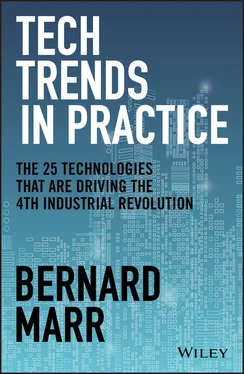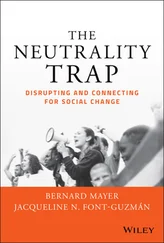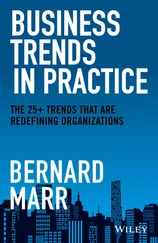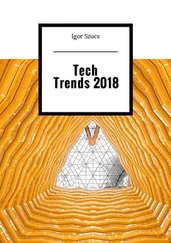Every business should consider whether they can use AI to improve their business in one or, ideally, all of these ways. But you’ll need a robust AI strategy in order to get the most out of AI – and a good AI strategy should always be linked to your overarching business strategy. To put it another way, you need to look at what the business is trying to achieve and then see how AI can help you deliver those strategic goals.
1 1 7 Indicators Of The State-Of-Artificial Intelligence (AI), March 2019, Forbes: www.forbes.com/sites/gilpress/2019/04/03/7-indicators-of-the-state-of-artificial-intelligence-ai-march-2019/#5d371cbb435a
2 2 White House Unveils a National Artificial Intelligence Initiative: www.nextgov.com/emerging-tech/2019/02/white-house-unveils-national-artificial-intelligence-initiative/154795/
3 3 More Robots Mean 120 Million Workers Will Need to be Retrained, Bloomberg: www.bloomberg.com/news/articles/2019-09-06/robots-displacing-jobs-means-120-million-workers-need-retraining
4 4How Did A Computer Beat A Chess Grandmaster?: www.sciencefriday.com/articles/how-did-ibms-deep-blue-beat-a-chess-grandmaster/
5 5Watson and the Jeopardy! Challenge: www.youtube.com/watch?v=P18EdAKuC1U
6 6AlphaStar: Mastering the Real-Time Strategy Game StarCraft: https://deepmind.com/blog/article/alphastar-mastering-real-time-strategy-game-starcraft-ii
7 7After 5,000 games, Microsoft’s Suphx AI can defeat top Mahjong: https://venturebeat.com/2019/08/30/after-5000-games-microsofts-suphx-ai-can-defeat-top-mahjong-players/
8 8AI learns to solve a Rubik’s Cube in 1.2 seconds: www.engadget.com/2019/07/17/ai-rubiks-cube-machine-learning-neural-network/
9 9 Boris Johnson pledges £250m for NHS artificial intelligence, The Guardian: www.theguardian.com/society/2019/aug/08/boris-johnson-pledges-250m-for-nhs-artificial-intelligence
10 10A comparison of deep learning performance against health-care professionals in detecting diseases from medical imaging, The Lancet: www.thelancet.com/journals/landig/article/PIIS2589-7500(19)30123-2/fulltext
11 11MIT AI tool can predict breast cancer up to 5 years early, works equally well for white and black patients: https://techcrunch.com/2019/06/26/mit-ai-tool-can-predict-breast-cancer-up-to-5-years-early-works-equally-well-for-white-and-black-patients/
12 12Infervision: Using AI and Deep Learning to Diagnose Cancer: www.bernardmarr.com/default.asp?contentID=1269
13 13The Search Engine AI That Reads Your Books: www.aidaily.co.uk/articles/the-search-engine-ai-that-reads-your-books
14 14Sony’s new AI drummer could write beats for your band: https://futurism.com/the-byte/sony-ai-drummer-write-beats-your-band
15 15MIT’s new AI can look at a pizza, and tell you how to make it: https://futurism.com/the-byte/mit-pizza-ai
16 16 Microsoft invests $1 billion in OpenAI to pursue holy grail of artificial intelligence: www.theverge.com/2019/7/22/20703578/microsoft-openai-investment-partnership-1-billion-azure-artificial-general-intelligence-agi
17 17 Facebook faces legal fight over facial recognition: www.bbc.com/news/technology-49291661
18 18 Amazon quietly adds “no human review” option to Alexa settings as voice AIs face privacy scrutiny: https://techcrunch.com/2019/08/03/amazon-quietly-adds-no-human-review-option-to-alexa-as-voice-ais-face-privacy-scrutiny/
19 19 The “right to an explanation” under EU data protection law, Medium: https://medium.com/golden-data/what-rights-related-to-automated-decision-making-do-individuals-have-under-eu-data-protection-law-76f70370fcd0
20 20 How Bias Distorts AI, Forbes: www.forbes.com/sites/tomtaulli/2019/08/04/bias-the-silent-killer-of-ai-artificial-intelligence/#260abf2e7d87
TREND 2 Internet of Things and the Rise of Smart Devices
The One-Sentence Definition
The Internet of Things (IoT) refers to the increasing number of everyday devices and objects that are connected to the internet and are capable of gathering and transmitting data.
What Is the Internet of Things?
The rise of smart devices has played a key role in the massive explosion of data (see Big Data, Trend 4) – and is rapidly changing our world and the way we live in it. But, in the IoT, data is created by things, not people, which has given rise to the term “machine-generated data.” How exactly are machines generating data? Typically, it’s when smart devices, gadgets, or machines gather information and communicate that data via the internet – an example being your fitness tracker automatically sending activity data to an app on your phone. (However, as we’ll see later in this section, in the future, devices will increasingly process the data themselves, without having to transmit it for analysis.)
This is all possible because, these days, pretty much everything is getting smarter. It all started with the iPhone, and has since snowballed to include smart TVs, smart watches, and fitness trackers (see wearables, Trend 3), smart home thermostats, smart fridges, smart industrial machinery…even smart nappies that alert you when your baby has, well, done what babies do best. A huge range of devices, machines, and equipment are now fitted with sensors and have the ability to constantly gather and transmit data. Today, even the smallest devices can effectively function as a computer. (However, it’s important to note that an actual computer wouldn’t count as part of the IoT, since the IoT generally refers to everyday objects that we wouldn’t traditionally expect to be able to connect to the internet – like fridges and TVs.)
An IoT device could be as small as a light bulb – smaller, in some cases – or as large as a streetlamp – see intelligent spaces and smart places, Trend 5 – and may be found at home, on our city streets, in our offices, in healthcare settings, in industrial settings, and more. I delve into some of the practical applications of the IoT later in the chapter.
The ability of machines to connect to and share information with each other is a key part of the IoT. These machine-to-machine conversations mean that devices can talk to each other and potentially decide on a course of action without human intervention. For example, manufacturing equipment fitted with sensors could transmit performance data to the cloud for analysis, and based on that data, the system could automatically schedule the equipment for repair and maintenance. (The use of the IoT in industrial and manufacturing settings is often referred to as “Industry 4.0” – smart industry, in other words.)
How big is the IoT? Pretty darn big. The IoT has experienced enormous growth in recent years and the popularity of smart devices shows no sign of slowing down. IHS predicts that 75 billion devices will be connected to the internet by 2025. 1If that number seems hard to fathom, consider this: as of January 2019, Amazon had sold more than 100 million smart devices with Alexa installed. 2That’s just Amazon Echo smart speakers and other Alexa-enabled devices! (Interestingly, many IoT devices are catching on to the power of voice interfaces like Alexa – see Trend 11.)
As well as becoming more ubiquitous, these smart devices are also becoming more powerful, which means that more of the computing can be done on them, rather than having to upload data to the cloud for analysis. This is what’s known as “edge computing” (see Trend 7). With edge computing, data is processed closer to the source of the data and away from the cloud – in theory meaning that your smart fridge could process data itself. It’s relatively early days for edge computing, but it’s predicted to bring big benefits. If you think about it, IoT devices create masses of data – not all of it critical – which can slow down processing and decision-making (fine if you’re just asking Alexa for the weather report, but definitely not fine in, say, a self-driving vehicle). With edge computing (see also Trend 7), networks are less clogged because more processing is happening closer to the data source, which means critical data can be handled much more quickly.
Читать дальше












